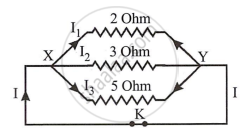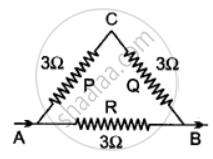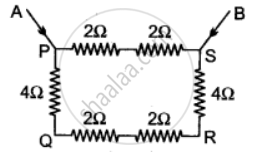Advertisements
Advertisements
प्रश्न
You have three resistors of values 2 Ω, 3 Ω, and 5 Ω. How will you join them so that the total resistance is less than 1 Ω? Draw a diagram and find the total resistance.
उत्तर
It is necessary to connect the resistors in parallel because we desire an effective resistance that is lower than the minimum value of the individual resistors.
∴ `1/"R" = 1/"R"_1 + 1/"R"_2 + 1/"R"_3`
`1/"R" = 1/2 + 1/3 +1/5`
= `(15 + 10 + 6)/30`
= `31/30`
∴ R = `30/31 < 1Ω`
R = 0.97 Ω

संबंधित प्रश्न
Complete the following :-
(b)

How many 176 Ω resistors (in parallel) are required to carry 5 A on a 220 V line?
A hot plate of an electric oven connected to a 220 V line has two resistance coils A and B, each of 24 Ω resistances, which may be used separately, in series, or in parallel. What are the currents in the three cases?
A wire of resistance R1 is cut into five equal pieces. These five pieces of wire are then connected in parallel. If the resultant resistance of this combination be R2, then the ratio `R_1/R_2` is:
(a) `1/25`
(b)1/5
(c)5
(c)25
State how are the two resistors joined with a battery when potential difference is same across each resistor.
Show how would you connect three resistors, each of resistance 6 O so that
the combination has a resistance of(a) 9 Ω (b) 4 .Ω
Tick (✓) the correct choice among the following :
Consider two cases of two parallel current carrying conductors. Current in
th e same direction and currents in th e opposi te directions will produce
Calculate equivalent resistance in the following cases:


What connection is used in domestic appliances and why?
Two resistors when connected in parallel give the resultant resistance of 2 ohms, but when connected in series the effective resistance becomes 9 ohms. Calculate the value of each resistance.
